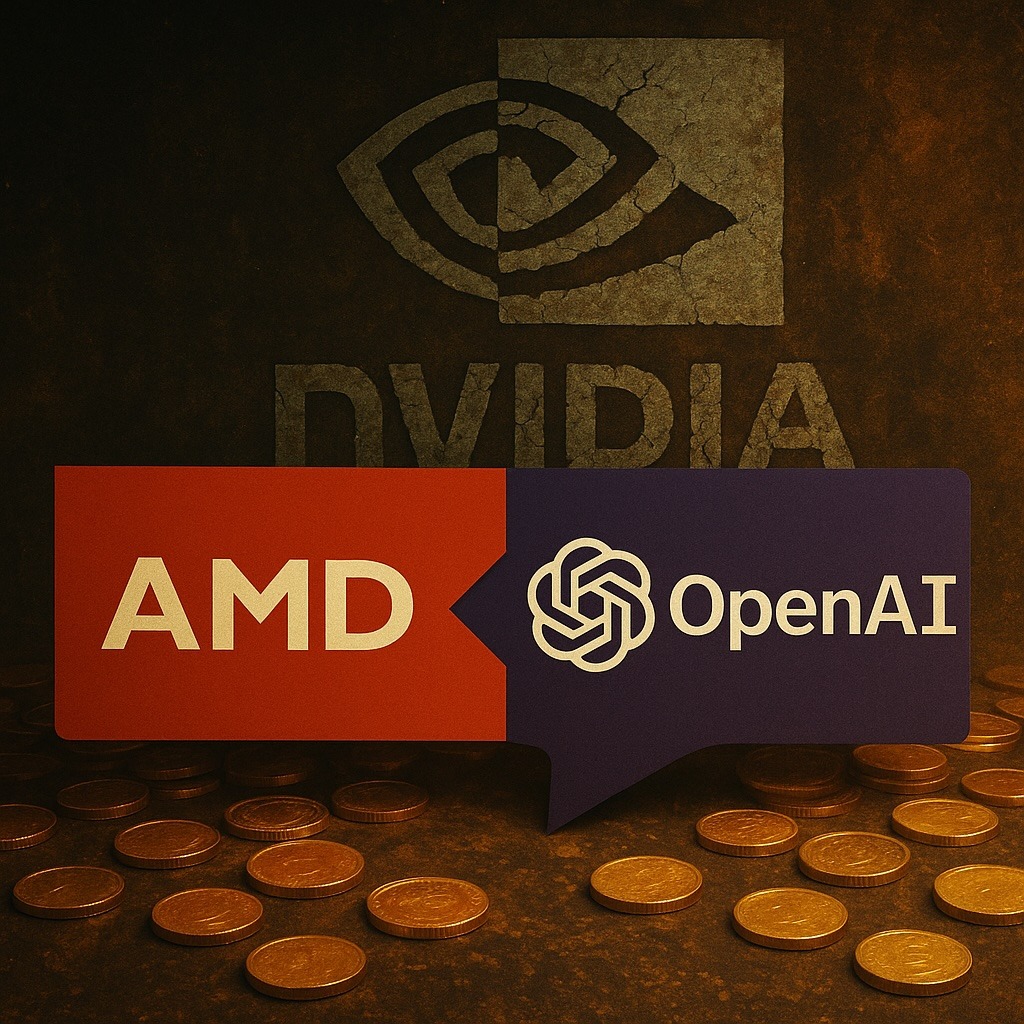
For nearly a decade, NVIDIA has been the unchallenged emperor of AI silicon. Its CUDA ecosystem was the moat, its GPUs the castle walls, and its profits, 75% margins to be exact, were the gold piled inside. Then OpenAI went and pulled a Julius Caesar. In October 2025, it forged a 6-gigawatt alliance with AMD, splitting its AI infrastructure between NVIDIA’s familiar green glow and AMD’s upstart Instinct hardware. On paper it’s diversification; in reality it’s an act of rebellion.
NVIDIA once powered OpenAI’s entire 10-gigawatt AGI factory. But the empire got greedy. The so-called “NVIDIA tax” made every new cluster an exercise in financial masochism. AMD’s new Instinct MI300X chips offered nearly double the VRAM capacity at a lower cost, crucial for training long-context LLMs that eat memory like locusts. For OpenAI, the maths was simple: reduce cost, hedge supply, and slowly chip away at dependence on a single vendor that’s become too powerful for comfort.
Behind the spreadsheets sits a deeper shift. The AI hardware world is entering its pluralist phase. AMD has finally clawed its way into competitive parity, while hyperscalers like Google, Amazon, and Meta are building their own silicon. Google’s TPUs already outperform general GPUs on price-to-performance. Amazon’s Trainium and Meta’s MTIA chips are following suit. It’s no longer about who builds the fastest chip, but who can control the full stack, from transistor to transformer.
NVIDIA isn’t just selling hardware anymore; it’s fighting for survival. Its strategy is to dig in with allies like Google DeepMind and AWS, offering tighter cloud integration and “coexistence through segmentation.” In other words, let Google use its TPUs internally, but make sure every external AI customer still rents NVIDIA silicon by the hour. It’s a clever plan, until the software moat crumbles.
The real danger to NVIDIA isn’t AMD’s hardware. It’s abstraction. Frameworks like JAX and XLA are making model training portable across architectures. Once developers can seamlessly compile PyTorch to any chip, the great CUDA lock-in dissolves. Suddenly, the battlefield shifts from “who has the best GPU” to “who has the cheapest compute per watt.”
And here’s the twist: NVIDIA’s dominance today is precisely what makes it vulnerable tomorrow. Its fortune is tied to a pre-AGI world where human engineers still dictate what gets built and how fast. But once general intelligence reaches maturity, when models can optimise their own code, architect their own chips, and negotiate their own contracts, NVIDIA’s role as the smartest designer in the room evaporates. The company that built the scaffolding for AI may find itself standing outside the building once the lights come on.
Imagine an AMD-OpenAI merger or a vertically integrated alliance where custom accelerators replace every off-the-shelf GPU. OpenAI already co-develops proprietary XPUs with Broadcom, and once those reach scale, NVIDIA’s best customer becomes its biggest existential threat. At that point, NVIDIA isn’t the world’s best chip designer, it’s just a supplier to yesterday’s paradigm. The hardware that trained AGI will no longer be the hardware that runs it.
So yes, NVIDIA looks unbeatable now. Record profits. Market cap higher than oil companies. The crown jewel of Silicon Valley. But beneath that shine is a rot of inevitability. If the future of intelligence is self-designed silicon, NVIDIA’s empire doesn’t get conquered, it simply gets left behind.
And while the corporations squabble over cost curves and throughput, governments are quietly militarising the chip race. The US CHIPS Act and similar EU efforts aim to secure domestic production in case Taiwan’s silicon shield ever cracks. China, of course, is building its own fortress, pouring billions into homegrown AI chips via Huawei and Alibaba, whose latest designs reportedly rival NVIDIA’s H20. The result is a bifurcated tech world, two parallel AI ecosystems divided by ideology and export restrictions.
The irony is that as machines grow smarter, the companies building them are reverting to caveman instincts, hoarding, guarding, and fortifying their fire. The AMD-OpenAI alliance is less a partnership than a declaration that no one wants to be ruled by a single supplier anymore. NVIDIA may still hold the crown, but the court is fracturing, and every player is sharpening their own blade.
If history’s any guide, empires rarely fall overnight. But they do fall. And when they do, it usually starts with a quiet deal signed behind closed doors, exactly like this one.